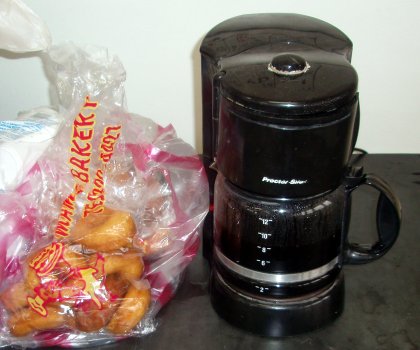
The 8:00 laboratory starts with coffee and donuts
The Cloud
I bring fresh showers for the thirsting flowers,
From the seas and the streams;
I bear light shade for the leaves when laid
In their noonday dreams.
From my wings are shaken the dews that waken
The sweet buds every one,
When rocked to rest on their mother's breast,
As she dances about the sun.
I wield the flail of the lashing hail,
And whiten the green plains under,
And then again I dissolve it in rain,
And laugh as I pass in thunder.
...
I am the daughter of Earth and Water,
And the nursling of the Sky;
I pass through the pores of the ocean and shores;
I change, but I cannot die.
For after the rain when with never a stain
The pavilion of Heaven is bare,
And the winds and sunbeams with their convex gleams
Build up the blue dome of air,
I silently laugh at my own cenotaph,
And out of the caverns of rain,
Like a child from the womb, like a ghost from the tomb,
I arise and unbuild it again.
- Percy Bysshe Shelley (1792-1822)
In previous laboratories we explored mathematical models, physical processes, and hypothesis testing. Laboratory eight had a different focus. Laboratory eight focused on observation, classification, and naming. Science has many fields that focus on careful observation and labeling. The ability to observe and accurately record observations are valuable scientific skills. Science has long depended on accurate and careful drawings of objects and phenomenon. The second part of this laboratory focused on observation of clouds and attempting to accurately capture a cloud.

The 8:00 laboratory starts with coffee and donuts
Among all animals, only humans appear to attempt to name objects in their surroundings. Western science has spent a great deal of effort on naming and classifying objects and phenomenon. Western science is not the only system that has produced naming and classification systems. The first part of this laboratory focused on naming.
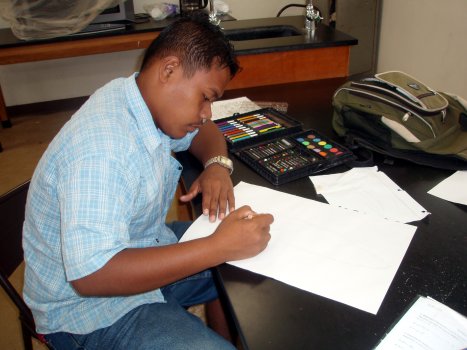
Stuard
The laboratory began with my reading of a riddle poem. I read the poem on the right, asking the students to try to determine "What am I?" By not revealing the title of the poem, and having not yet handed out the laboratory, the students did not have a direct clue as the poem never includes its own title word.
For this laboratory the data table was generated by the class. The class assembled a list of weather words in their own languages. Words such as sky, cloud, fog, rain, wind, thunder, lightning, morning dew, storm, typhoon, and rainbow. The class examined whether there was only one word for each phenomenon or many words.
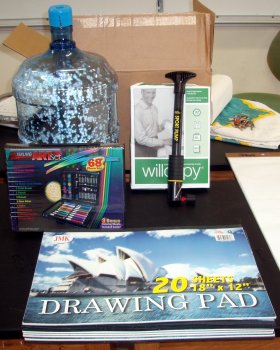
Supplies for this laboratory included a cloud chamber

Art kit detail
The students will be turning in their completed tables next week.
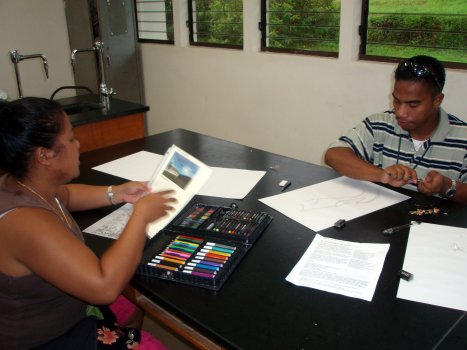
Ivyleen and Maverick drawing
A tin can cloud demonstrated condensation, collision, coalescence, and tropical rain. The "cloud" was hung from the overhead rail and dripped into the sink. The can started off dry, with ice added at period start.
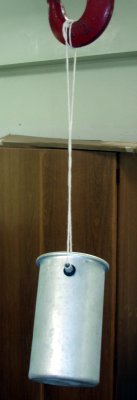
Tin can cloud
Hamlet: Do you see yonder cloud that's almost in shape of a camel?
Polonius: By the mass, and 'tis like a camel, indeed.
Hamlet: Methinks it is like a weasel.
Polonius: It is backed like a weasel.
Hamlet: Or like a whale?
Polonius: Very like a whale.
- Hamlet, Act iii Scene 2, William Shakespeare, 1602
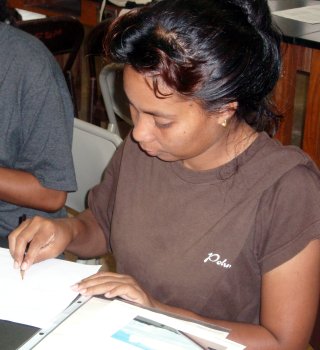
Mina drawing
Prior to 1800 clouds were seen as ephemeral, ever changing, impermanent, and thus difficult to categorize or name. In 1802 an Englishman named Luke Howard developed a systematic way to name clouds. Impressed by the Latin naming system designed by Carl von Linné for classifying plants and animals, Howard devised a Latin-based language system for classifying and naming clouds. Howard's system made sense to scientists. With some modifications, this is the system the world uses to this day. The descriptions are Howard's original descriptions.
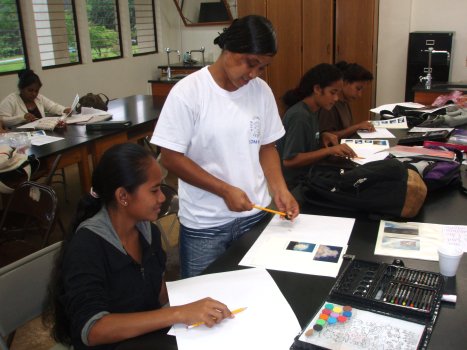
Yahne and Priana at work
Howard extended his system with descriptions for unusual types of clouds.
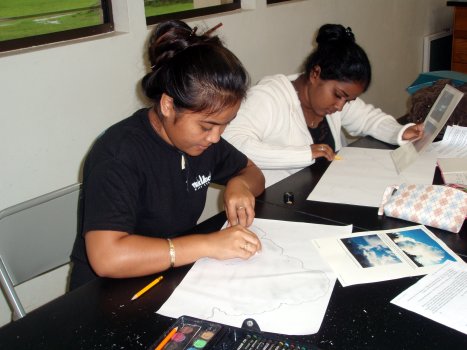
Renee and Vishani
One modification has been to add a prefix to the middle and high level clouds. Thus we now speak of altoculumulus, altostratus, and cirrostratus clouds. Alto- refers to middle level clouds, cirro- to the highest level clouds. Low clouds get no prefix. Some clouds have bottoms at the low level and tops at the high level. These are vertically developed clouds and usually produce precipitation. These clouds are usually cumulonimbus clouds, a term that combines two of Howard's cloud terms. You and I think of the largest cumulonimbus as clouds that produce heavy rain, wind gusts, and occasional lightning and thunder.
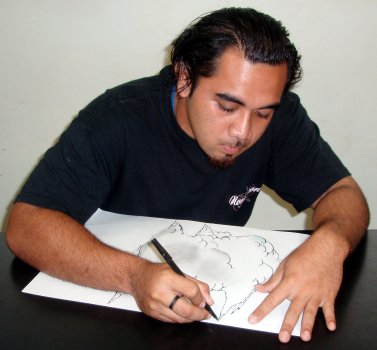
Harry works on a anvil-top cumulonimbus
Here on Pohnpei the top of our ridges are 700 to 800 meters high (2000 to 2500 feet). The bottoms of cumulus clouds are often also around this high. Cloud bottoms can be lower, and when the cloud reaches the ground the term used is "fog."
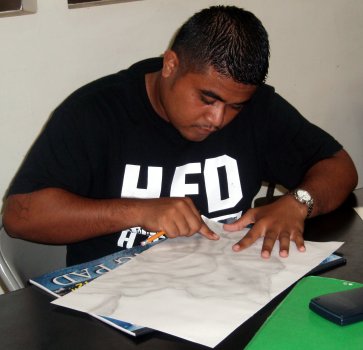
Garry at work
A second modification is that Howard's extended cloud names are often now used to modify one of the four basic cloud types. Cumulis humilis and cumulus congestus are examples of this naming system.
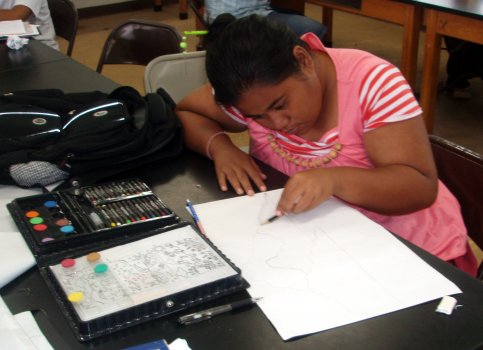
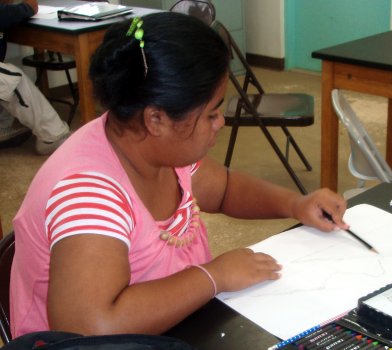
Tracy
Each student produced as accurate a drawing of an actual cloud as the student could accomplish. Here the goal was observing carefully and trying to accurately capture a realistic image of an actual cloud. Lab partner pairs had to share an art set kit. The art sets were useful, but ultimately worth only the $3.99 per set paid for them. The oil pastels were not the consistency of true Cray-Pas® and crumbled when used. The crayons were too waxy and did not have the quality of Crayola® crayons.
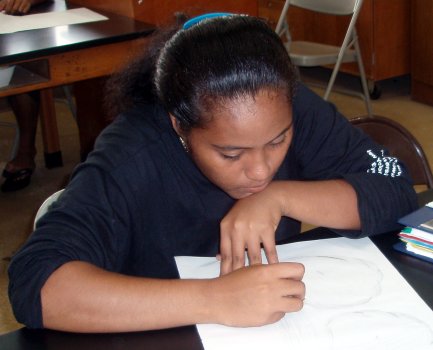
Teine
Initially we were to observe clouds as carefully as we could, making any necessary sketches on eight and half by eleven paper before returning to the lab room to work on actual drawings. Pohnpei, however, did not cooperate and threw us a day a of continuous rain from a solid gray overcast sky. We had clouds, a solid deck of clouds at about 500 meters. There were no shapes to be seen from the bottom of the cumulonimbus deck. There was certainly no lack of precipitation.
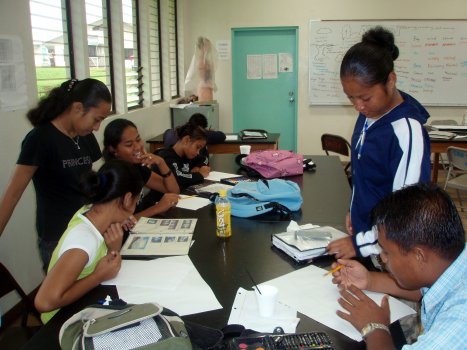
Late in the period students walked around to admire each other's work
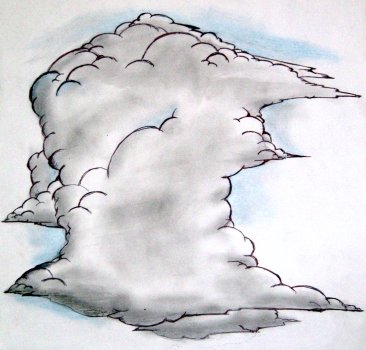
Cumulonimbus
Students were to discuss weather words that appeared related or connected in some way. The conclusion was left fairly open-ended and ill-defined for this unusual laboratory. A discussion of quality of drawings in the sections was met with an initial reaction that all students drew to the best of their own individual ability and thus all drawings were of equal merit. Then someone saw one particular drawing and went, "Ooooh. That's good." How to tease apart the natural inclination to distribute credit equally without regard to quality from the reality that there are quality differences escapes me at present. Definitely a Pirsigian issue.
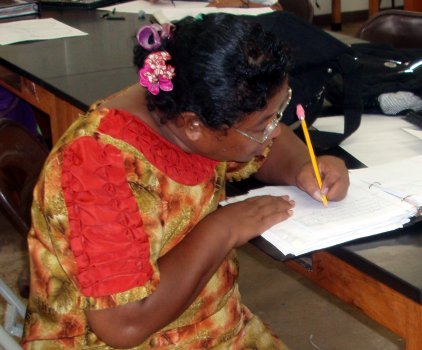
Melly